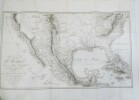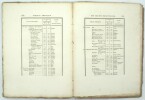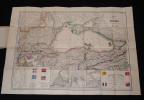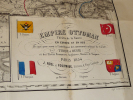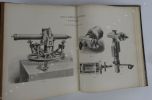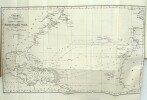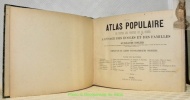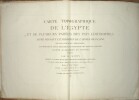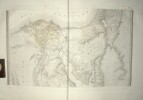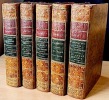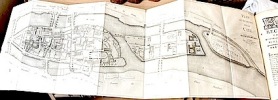-
Type
Book (1122)
Drawings (1)
Magazine (10)
Maps (57)
-
Latest
Last 24h (1)
Last 3 days (1)
Last month (5)
Last week (1)
-
Language
English (1)
French (1185)
German (3)
Portuguese (1)
-
Century
16th (4)
17th (27)
18th (56)
19th (161)
20th (228)
21st (51)
-
Countries
Belgium (262)
Brazil (1)
Canada (5)
China (1)
Côte d'Ivoire (4)
France (647)
Italy (46)
Switzerland (224)
-
Syndicate
ALAC (5)
ILAB (391)
NVVA (130)
SLACES (130)
SLAM (149)
SNCAO (2)
Essai politique sur le royaume de la Nouvelle-Espagne.
Paris, F. Schoell, 1811 ; 5 vol. in-8, relié veau raciné, dos lisse orné, pièces de titre et de tomaison rouge, tranches marbrées, illustré d’un plan dépliant et d’une grande carte par Poirson. Édition originale au format in-octavo, conforme à celle in-4 de 1811, 2ff-iii-456, 2ff-520pp-1ff, 2ff-419pp ,2ff-564pp-1ff . Rongés avec manques de cuir, épidermures, intérieur frais.
Sur permission de Charles IV d'Espagne, Alexandre de Humboldt, accompagné de son ami Aimé Bonpland, put parcourir la Nouvelle-Espagne, qui couvre les régions modernes de l'Utah, la Californie, l'Arizona, le Texas, le Nouveau-Mexique, le Mexique, Guatemala, Honduras, Nicaragua, Costa Rica, Panama, et partie du Venezuela et de la Colombie .Il passe cinq ans dans les jungles parcourant d'immenses territoires inexplorés de l'Amérique du Sud et Centrale à pied, en canoë (rapides de l'Orénoque, ), à dos d'âne, tout en rassemblant des données géologiques, topographiques , zoologiques ,botaniques, atmosphériques... Outre ses descriptions , il dressa un état économique , démographique des possessions espagnoles au nouveau monde , décrit les mines et les terres mais n’oublia de montrer les mauvais traitements infligés par les colons espagnols sur les populations indigènes et les esclaves noirs,préfigurant le schisme entre les créoles et les espagnols . Humboldt recommanda au roi d’Espagne une plus grande émancipation des populations indigènes comme il l’écrit dans sa dédicace « Comment pourrait-on déplaire à un bon Roi, lorsqu’on Lui parle de l’intérêt national, du perfectionnement des institutions sociales et des principes éternels sur lesquels repose la prospérité des peuples ? » Avec sa carte réduite de la nouvelle Espagne, la plus exacte des cartes du Grand Ouest américain à cette date, elle est l'une des plus importantes de l'histoire de la géographie. Dressée au terme du voyage d'exploration de Humboldt entre 1799 et 1804, elle détaille le relief de ces territoires, les Indiens qui l'habitent, ainsi que chacune des églises ou monastères construits par les Espagnols, elle illustre l'attention sans faille que porte Humboldt aux populations indiennes du continent. Elle détaille leurs territoires (des Natchitoches à l'est à la Baja California à l'ouest, et du Mont Timpanogos dans l'Utah à Tehuantepec au sud) en soulignant la topographie des terrains, et en nommant chacune des tribus. L’auteur (1769-1859), célèbre voyageur et naturaliste allemand, a laissé une œuvre monumentale relatant ses découvertes lors de ses voyages en compagnie du naturaliste Aimé Bonpland. Son étude sur le Mexique se compose de 6 parties et l’Essai politique sur le royaume de la Nouvelle-Espagne constitue la troisième partie du voyage d’Alexandre de Humboldt et de Aimé Bonpland aux régions équinoxiales. M4-Et3
Essai sur la géographie des plantes, accompagné d'un tableau physique des régions équinoxiales, fondé sur des mesures exécutées, depuis le dixième degré de latitude boréale jusqu'au dixième degré de latitude australe, pendant les années 1799, 1800, 1801, 1802 et 1803
Paris, Tübingue, F. Schoell, J.G. Cotta, 1807, folio, reliure d’attente, 3ff.- 155pp., dos manquant, 1er plat détaché, coins usés, sans la planche annoncée, petites rousseurs.
Premier ouvrage scientifique publié par Humboldt à son retour de voyage en Nouvelle Espagne, il était accompagné d’un tableau (absent ici) vendu séparément et représentant l’étagement des plantes selon l’altitude sur le Chimborazo (volcan d’Équateur), ce qui en fait l’une des premières représentations d’une répartition des espèces. Sur permission de Charles IV d'Espagne, Alexandre de Humboldt, accompagné de son ami Aimé Bonpland, put parcourir la Nouvelle-Espagne, qui couvre les régions modernes de l'Utah, la Californie, l'Arizona, le Texas, le Nouveau-Mexique, le Mexique, Guatemala, Honduras, Nicaragua, Costa Rica, Panama, et partie du Venezuela et de la Colombie .Il passe cinq ans dans les jungles parcourant d'immenses territoires inexplorés de l'Amérique du Sud et Centrale à pied, en canoë (rapides de l'Orénoque, ), à dos d'âne, tout en rassemblant des données géologiques, topographiques , zoologiques ,botaniques, atmosphériques..., très rare. M2-Et0
Carte de l'Empire Ottoman, théâtre de la guerre en Europe et en Asie, dressée par Hérisson, 1854
J. Noël et Fourmage, éditeurs Carte 1854 Carte ancienne (env. 87 x 63 cm dépliée), de l'Empire Ottoman, théâtre de la guerre en Europe et en Asie, dressée par Hérisson, comprenant un plan de Constantinople, de Chouma et ses environs, de Varna et de Silistrie, ainsi que de magnifiques ornements aquarellés (drapeaux), 2e édition, 1854 ; un petit défaut dans la marge gauche, par ailleurs très bel exemplaire. Livraison a domicile (La Poste) ou en Mondial Relay sur simple demande.
L’Ile aux trois pointes. Cartes de la Sicile de la collection La Gumina.
Sans lieu, Regione Siciliana 2001, 230x220mm, 189pages, broché. Bel exemplaire.
photos couleurs, Pour un paiement via PayPal, veuillez nous en faire la demande et nous vous enverrons une facture PayPal
Jonction géodésique et astronomique de l'Algérie avec l'Espagne, exécutée en commun en 1879, par ordre des gouvernements d'Espagne et de France,
Paris, Imprimerie Nationale, 1886, in-4 (266 x 213 mm.), page de titre, XIX-281 pp.,1 carte n/b, 7 planches doubles, 2 planches, 1 pl. double couleurs, reliure demi-basane, dos lisse, dos gratté en tête (cachet ou étiquette supprimé), épidermures et début de fente au mors (20 mm.), traces de colle sur contre plats, défaut page de titre : certainement un cachet de bibliothèque supprimé en grattant (petit manque et papier plus fin) et angle découpé (45 x 55 mm.) et restauré, restauration au feuillet 2 : 60 x 45 mm., bel état intérieur, bel exemplaire.
Le Rêve de la carte parfaite : cartographie et mathématiques
RBA Le monde est mathématique Cartonné 2013 "In-8 (16,5 x 23,5 cm), cartonné, 177 pages, n°22 de la collection ""Le monde est mathématique"" ; très bon état. Livraison a domicile (La Poste) ou en Mondial Relay sur simple demande."
Eduard Imhof, Werk und Wirken. (Alpenmaler und Kartograph). Geleitwort von Hans Peter Tschudi. Beiträge von Hans Hauri, Erwin Gradmann, Willy Furter und Ernst Spiess.
Zürich, Orell Füssli, 1970, in-4°, 95 S., ill., Original-Pappband, OU.
Image disp.

(SLACES, NVVA)
Phone number : 41 (0)26 3223808
Gelände und Karte. (Mit der 3-D. Stereo-Brille).
Erlenbach-Zürich, Eugen Rentsch, 1950, in-4°, 254 S. mit 34 farb. Karten- und Bildertafeln und 343 Abb., + 1 spez. rot/blau Beiliegend: Stereobrille, Original-Leinenband. Erstausgabe. Schönes Exemplar.

(SLACES, NVVA)
Phone number : 41 (0)26 3223808
HISTORISCHE STEDENATLAS VAN BELGIE : MECHELEN.
Brussel, Gemeentekrediet, 1997 Gebonden,beige linnen hardcover, originele uitgeversomslag met flappen in kleur, 34.2x24.7 cm., 157 pp. + 2, geillustreerd in kleur en in z/w. *als nieuw ISBN 9050661785.
Deze uitgave wil een overzicht brengen van de ontwikkelingsgeschiedenis van de stad vanaf het onstaan tot het einde van het Ancien Regime en is geillustreerd met talrijke oude en nieuwe kaarten en stadsgezichten.
A History of the Life and Voyages of Christopher Columbus.
Paris, Baudry, 1828. 4 volumes in-8 (18,5 x 10,5 cm), reliés plein cartonnage d’époque, dos lisse avec pièces de titre et tomaison, quelques frottements aux pièces, coins légèrement usés, très peu de rousseurs. Illustré d’une carte dépliante en frontispice du premier volume.
Première édition parisienne en anglais de la célèbre biographie de Christophe Colomb par Washington Irving, publiée la même année que les éditions de Londres (John Murray) et de New York (Carvill). L’éditeur Baudry, spécialisé dans la diffusion des auteurs britanniques sur le continent, proposa ce tirage destiné au lectorat anglophone de Paris et des voyageurs européens. L’ouvrage, fondé sur des recherches dans les archives espagnoles, fut la première biographie moderne du découvreur, alliant rigueur documentaire et style littéraire. Irving y retrace la vie, les voyages et le contexte intellectuel du génois, cherchant à réhabiliter la figure de Colomb en explorateur inspiré et chrétien éclairé. Le texte eut une influence durable sur l’historiographie américaine et sur l’image romantique du découvreur dans toute l’Europe. La grande carte dépliante, souvent absente, complète cet exemplaire bien conservé. M4-Et3 Sabin 35173 ; Palau 124849 ; Howes I-85.
Phone number : 06.31.29.75.65
Atlas populaire de toutes les parties de la Terre a l’usage des ecoles et des familles. Complet en 28 cartes typographiques colorieés.
Gera, Issleib & Rietzschel sans date, 230x290mm, reliure demi-toile avec palts papier marbré. Format à l’italienne. Plats et toile frottés par endroits, autrement non état, intérieur propre.
collation: complets des 28 cartes en couleurs, Pour un paiement via PayPal, veuillez nous en faire la demande et nous vous enverrons une facture PayPal
Kaartboek van de abdij van Affligem 1717-1756.
, Algemeen Rijksarchief en Rijksarchief in de Provincien, 2003 Gebonden, linnen met stofwikkel, 326pp., 24.5x34.5cm., ills; in kleur, zeer goede staat.
Boek Het Caertbouck van Steeckenen (1668-1674) en zijn kadastrale kaarten
, Provincie Oost-Vlaanderen 2018, 2018 Hardcover, 400 pagina's, Nederlands, 345 x 250 x 45 mm, Nieuwstaat, met Kaarten, illustraties / foto's in kleur en z/w,. ISBN 51961.
Het boek gaat over het landboek van Stekene en bevat informatie over alle percelen die in Stekene liggen en over de eigenaars ervan in de periode 1668-1674. Ook de prachtige ingekleurde kaarten zijn in het boek opgenomen. Bovendien is onderzoek verricht naar de molens, naar de steenbakkerijen, naar de wegen, naar de watermerken en zoveel meer. Als extraatje kan je mee op speurtocht naar een verdwenen grenspaal die op basis van het Landboek onlangs werd teruggevonden.
ARTS ET LEGENDES D’ESPACES, Figures du voyage et rhétoriques du monde.
Presses de l’Ecole normale supérieure, Paris, 1981.
Un volume in 8°, broché, couverture souple éditeur (ornée d’une gravure ancienne sur fond jaune), 303 pages.
JACOTIN (Pierre), PANCKOUCKE (Éditeur), JOMARD (Dir. De la publication)
Reference : PHO-2137
(1826)
Description de l’Égypte ou recueil des observations et des recherches qui ont été faites en Égypte pendant l’expédition de l’armée française, seconde édition …. Atlas géographique
Paris, Imprimerie de C.-L.-F. Panckoucke, 1826, Folio éléphant (72x55), 54 feuilles, demi reliure, dos lisse orné, défauts (coins très usés, frottements, manque au dos, coiffes abimées, etc…), mouillure angulaire, petites rousseurs, piqures sur les 2 dernières planches.
Titre, second titre en double page, table d’assemblage, tableau des Caractères Topographiques et Alphabet Harmonique, Carte géographique réduite en 3 feuilles datée de 1822 et 47 feuilles en double page, reprenant l’ensemble des levés topographiques établis sous la direction de Jacotin durant l’Expédition d’Égypte ; la majorité des feuilles sont en double page, avec 6 en simple page, l’ensemble imprimé en très grand format, cuvette 85 × 56 cm, impressions 49 × 82 cm et 51 × 82 cm selon les segments. Les planches détaillent la cartographie du Delta, de la vallée du Nil jusqu’à la Nubie, des principaux centres urbains et des zones archéologiques, constituant l’atlas géographique spécifique à l’édition Panckoucke.
Albums de Croÿ, Tomes XIV-XV-XVI : Comté de Namur I, II et III [3 volumes]
Bruxelles, Crédit Communal de Belgique 1986-1991 Tomes 12-13, 190 + 305 + 224pp., avec 288 planches en couleurs pleine-page, reliures cart. d'éditeur, jaquettes, 34cm., très bon état, poids: 7 kg., [Contenu: Tome XIV: Institutions religieuses et villes, Mairie de Namur // Tome XV: Bailliages de Bouvignes, Fleurus, Viesville et Wasseiges // Tome XVI: Mairie du Feix, Bailliage de Samson, Prévoté de Poilvache], B119082
Le principe de symétrie et ses applications. Traduit de l’anglais par Pierre Gérald, Jean Chevrier. Préface de M. Charles Moureu.
Paris, Gauthier-Villars et Cie. Libraires du Bureau des Longitudes, de l’Ecole Polytechnique 1925, 240x155mm, XV - 420pages, broché. Cachet de possesseur sur le haut de la couverture supérieure, autrement bel exemplaire avec pages non coupées.
illustrations n/b in texte, Pour un paiement via PayPal, veuillez nous en faire la demande et nous vous enverrons une facture PayPal
Carte : Partie du cercle d'Austriche divisé en haute et basse par le Sr. Sanson, géographe ordinaire du Roy
Jaillot H. Carte 1677 Cartes en deux parties, 55 par 86 cm, titre hors cartouche : partie du cercle d'Austriche sçavoir l'archiduché d'Austriche divisé en Haut ou au dessus de l'Ens et Bas ou au dessous de l'Ens ; frontières surlignées en couleur, mouillure en marge inférieure, bon exemplaire. Livraison a domicile (La Poste) ou en Mondial Relay sur simple demande.
Carte : Partie du cercle d'Austriche divisé en haute et basse par le Sr. Sanson, géographe ordinaire du Roy
Jaillot H. Carte 1677 Cartes en deux parties, 55 par 86 cm, titre hors cartouche : partie du cercle d'Austriche sçavoir l'archiduché d'Austriche divisé en Haut ou au dessus de l'Ens et Bas ou au dessous de l'Ens ; frontières surlignées en couleur, mouillure en marge inférieure, bon exemplaire. Livraison a domicile (La Poste) ou en Mondial Relay sur simple demande.
Recherches critiques, historiques et topographiques sur la ville de PARIS, depuis ses commencements connus jusqu'à présent; Avec le plan de chaque quartier.
Auteur, Lottin Paris 1772-75 5 vol. 5 vol. in-8 de 2 ff.n.ch. XXIV 216 pp. 79 pp. 56 pp. 58 pp. et 94 pp., 2 ff.n.ch. 64 pp. 2 ff.n.ch. 51 pp. 1 f.n.ch. 40 pp. 2 ff.n.ch. 94 pp. et 2 ff.n.ch. 94 pp., 3 ff.n.ch. 56 pp. 1 f.n.ch. 36 pp. 1 f.n.ch. 40 pp. 1 f.n.ch. 48 pp. et 1 f.n.ch. 138 pp., 3 ff.n.ch. 181 pp. 1 f.n.ch. et 1 f.n.ch. 234 pp. 1 f.n.ch., 3 ff.n.ch. 150 pp. 1 f.n.ch. 1 f.n.ch. 120 pp. 1 f.n.ch. 88 pp. et 92 pp. (table), plein veau fauve marbré de l'époque, dos lisse orné, pièces de titre et de tomaison, tranches rouges (accroc à la coiffe supérieure du tome V).
EDITION ORIGINALE de cet excellent ouvrage connu pour son exactitude historique et topographique (Lacombe 851). Chaque fascicule possède ses faux-titres et titres datés. Edition agrémentée de 25 plans dépliants exécutés par Perrier, certains d'un très grand format. Exemplaire complet de la Table alphabétique des XX parties des Recherches sur Paris, et enrichi au début du tome V, de la "Réponse de M. Jaillot… à quelques Lettres Critiques sur son Ouvrage". Plaquette in-8 de 24 pp. "L'auteur, érudit et géographe du XVIIIe siècle, mort à Paris le 5 avril 1780. Appartenant à une famille d'artistes et de cartographes, géographe ordinaire du roi, membre de l'Académie royale des sciences et belles-lettres d'Angers. C'est surtout au point de vue topographique que ces Recherches sont recommandables : à une époque où les archives du royaume et celles des établissements religieux n'étaient pas d'un accès aisé, Jaillot a su se les faire ouvrir et s'est appliqué, avec un esprit critique, parfois un peu subtil, à ne fonder son travail que sur des documents inattaquables". Malheureusement cet exemplaire a été relié à l'époque dans un ordre complètement arbitraire, certains quartiers ont été intervertis dans les différents tomes. Pouvons-nous croire que le relieur a opter pour une visite de la ville en partant du coeur et se terminant par la périphérie. Très bon exemplaire dans sa reliure de l'époque, provenant de la bibliothèque de L. Vaudoyer avec son ex-libris (architecte au XIXème siècle).
Carte : Basse partie de l'évéché de Munster et le comté de Benthem tiré des mémoires les plus récents, par le Sr. Sanson géographe ordinaire du Roy
Jaillot H. Carte 1674 Carte de 43 x 57 cm en une partie : frontières colorées ; petites déchirures marginales sans gravité, bon exemplaire. Livraison a domicile (La Poste) ou en Mondial Relay sur simple demande.
Carte : La seigneurerie d'Utrecht dressé par le Sr. Sanson Géographe Ordinaire du Roy à Paris chez H. Jaillot
Jaillot H. Carte 1675 Carte de 41 x 56 cm en une partie : frontières colorées ; petits défauts, très bon exemplaire. Livraison a domicile (La Poste) ou en Mondial Relay sur simple demande.
Carte : La seigneurerie d'Utrecht dressé par le Sr. Sanson Géographe Ordinaire du Roy à Paris chez H. Jaillot
Jaillot H. Carte 1675 Carte de 41 x 56 cm en une partie : frontières colorées ; petits défauts, très bon exemplaire. Livraison a domicile (La Poste) ou en Mondial Relay sur simple demande.
Carte : Le duché de Berg, le comté de Homberg, les seigneuries de Hardengberg et de Wildenborg dressé sur les mémoires les plus récents par le Sr. Sanson géographe ordinaire du Roy
Jaillot H. Carte 1695 Carte de 43 x 57 cm en une partie : frontières colorées ; petites déchirures marginales sans gravité, bon exemplaire. Livraison a domicile (La Poste) ou en Mondial Relay sur simple demande.
 Write to the booksellers
Write to the booksellers

